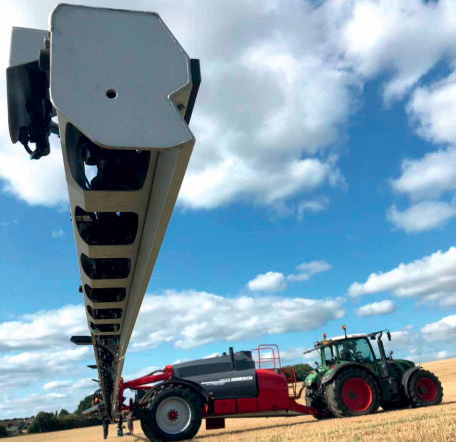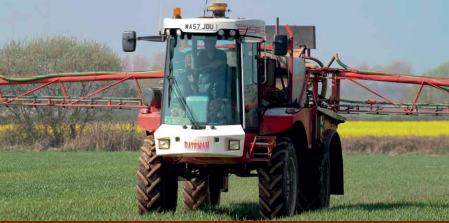
18 years ago, we bought our first self-propelled sprayer and it revolutionized access to land, it was light and well balanced and made fertilizer and crop protection applications easy. Our timeliness and the ruts we used to leave in tramlines all but disappeared.
Back then If you had told me I would ever consider running a trailed sprayer on my farm again I would have thought you were mad. I was once told the difference between a good farmer and a bad one was “a week” so I have always placed ability to travel and make timely application of inputs highly on my list of farming priorities. So why today do I find myself the proud owner of a new trailed sprayer? Both bigger and heavier than any sprayer we have ever run before, and why am I more confident than ever of timely application with this heavy weight monster? What changed? Soil is what changed, and nothing is more demonstrative of that than this increased ability to carry traffic.
The improved structure that has resulted from zerotill can be seen through infiltration tests proving how its structure today can far better cope with rainfall events. Like many other UK farmers most of the land we farm has a now ageing drainage system under it, these systems were put in when grant money for such infrastructure investment was available. Tighter economics means many such systems are now getting tired and becoming less effective and in need of investment which for many is simply just not available. Drainage is essential to consistently successful zero till but doing so with a digger and pipes is a very long-term investment and certainly not something many tenant farmers would consider on a short-term contract.

Under our previous min-till system ponding was not uncommon and wet spots that could swallow a sprayer lay in wait to catch us out when pushing application windows after significant rainfall. Each year of zerotill these areas seemed to get smaller, the temptation to subsoil them was resisted in favor of a light late spring surface cultivation and cover crop mix established on any such bare patch or sticky headland, nothing repairs structure better than roots and the soil biology that surrounds them and it seems that if you can create a good natural structure it can go some way to making up for the failings of an ageing 1960’s drainage scheme.
Get enough wildlife working through your soils vertically and they create a massive network of small drainage channels that can quickly help move water from the surface down to storage in subsoils or out to existing drains very quickly. Worms do this very effectively and I have seen studies that show the combined area of the galleries they can create in a long term zero till soil can total the equivalent of a 4” drain every square meter of the land, if you try to visualize what that would look like it’s very difficult to imagine water ponding on any surface with a vertical drain every square metre.
Less is more when it comes to creating structure, if you plough 10” then then a heavy load will easily break through that 10” of structureless soil, if you min-till to 6” that will be the depth of your ruts when making applications in less than ideal condition, however if you don’t cultivate at all eventually your natural structure will improve to a point where it can carry much greater loads before failing. Cultivations simply destroy the essential channels and break down aggregated structures created by soil life making it a lot harder for water to flow away from the cultivated zone. This means in high rainfall events the soils soon reach capacity making it impossible to traffic and, in many cases, leads to run off, soil erosion and resulting pollution and sedimentation of our water courses.
Of course, soil doesn’t change overnight, it’s a gradual process so getting to a point where increased structure and infiltration can carry heavy loads needs thought and planning. I’m not a big fan of strict controlled traffic farming systems (CTF). Along with the often-high capital cost of adoption I have always felt it dictates too much, causing compromises with important residue management strategies. Although maybe a necessity in farming systems that depend greatly on very heavy high horse power tractors my view is that it’s surely better to just not use potentially damaging machines when you have viable lighter, lower ground pressure alternatives usually employed in zerotill systems.
A less prescriptive form of CTF has however played a vital part when it comes to the parts of our farming system where weight is unavoidable or ideal conditions not always possible. In our case this has been controlled traffic of application and harvest equipment. Fixing tramlines and boom / header width in multiples of 12m has helped us keep damage from such operations localized and allowed targeting of any remedial work. In the early years of system change such remedial work consisted of just leveling any rutted areas and resisting temptation to work deeply which would simply put any longer-term changes to structure right back to square one. Gradually the ruts got shallower and less frequent the heavily trafficked application tramlines became settled and compacted preventing deeper sinking. Our route onto the land had become more stable whilst the soil around it had become better able to infiltrate and cope with weather significantly increasing our windows of application.
Increased workload over the last decade means today we need more application capacity than ever, our self-propelled machine was ageing and replacement long overdue. The tractors we use today are much smaller than they were and with almost no cultivation to do are covering less hours than they ever did making them the perfect match for a modern self-propelled sprayer. The capital cost of a similar spec self-propelled machine was over double that of an equivalent trailed machine. From a financial point of view the savings from the change are significant and fit in well with the ethos behind our farming system of keeping things as simple, minimal and as few engines (which equals potential repair bills!) on the farm as possible.

It’s not all positive however, tractors don’t have the clearance of a self-propelled machine and changes between row crops and low ground pressure wheel equipment would take longer and be more frequent, trailed machines are not as “handy” in the smaller fields, backing into corners and working around obstacles. These are compromises we considered long and hard before making the decision to change. To mitigate this, we have moved from 24m to 36m tramlines. 36m still fits with the harvest operation where we control the unavoidably heavy machinery and 12m base organic fertilizer and lime applications yet even when running wide tractor tyres all year around the area lost to uncropped tramlines and reduced ground clearance is not much more in percentage terms than that lost to narrow wheels on a 24m system.
Farming systems are often compared primarily on agronomic merit. Often the first thing I am asked about our transition to zerotill is how do the crops yield? or what are gross margins like? Others are interested in the operational cost savings we have made like fuel and wearing metal. Although not insignificant none of these things are where the truly fundamental business changing difference are. Zerotill creates opportunity for complete business restructure, radically different rotations that include higher % of spring cropping may provide lower rotational average gross margins, but they also provide serious scope for cost cutting as well. UK agriculture has been obsessed with gross margin for too long and has lost sight of more fundamentally important profitability.
Chasing the maximum output rainbow has led many of us to unsustainable rotations and the current decline in soil health bringing symptoms like blackgrass, pest, disease or plateauing and even declining yields for some. As my recent change to a trailed sprayer demonstrates, smaller tractors add flexibility in their use and without cultivations to complete along with their drivers have more time available for more varied “allrounder” operations. The restructure here has been gradual, we never had a farm sale or made anyone redundant, we let things evolve and made machinery changes as and when they needed making and, in many cases, simply took on more work without needing to invest in additional infrastructure to complete it.
Today our capital employed per acre is less than half the level it was when we mintilled and a quarter of the level I believe would be required should we return to the plough, depending on circumstance that reduces debt and its cost or provides capital to expand or diversify. The increased diversity and spread of our rotation has reduced average gross margin, spring break crops will never compete with the output of a decent crop of winter OSR but with a lot less bills to pay does that really matter? These fixed costs savings are what makes the difference and will become essential in the potentially un subsidized trading environment we all face in the years ahead The big question is though as small becomes the new big here just how far will things go? Will I look back on this in years to come while my swarms (if that’s the correct collective noun) of robots work the land and laugh at what I once thought was “small”? Will my recent purchase be my last sprayer? There are some exciting times ahead of agriculture, nothing short of an agricultural revolution is on our doorstep and I really can’t wait for the many exciting challenges and changes that will bring.
